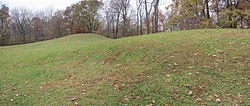Toolesboro Mound Group
Introduction
Text-to-speech Audio
The Toolesboro Mound Group is a group of Havana Hopewell culture earthworks. They are located on the north bank of the Iowa River near its discharge into the Mississippi River. The mouth of the Iowa River was a superb location for people skilled in hunting and the gathering of food. Some of the dead placed in the mounds were either layed in a sitting postition or creamated, while some were placed in charnel houses where the bodies would decompose, then the boides were later buried.
Images
Toolesboro Mound Group

Backstory and Context
Text-to-speech Audio
The Hopewell culture was a Native American
celebration of the economic surplus, in food and other goods, created
by harvesting the natural wealth of the American Midwest. Native
Americans, in the Hopewell period, buried their dead in earthen mounds, accompanied by grave goods that displayed their status and possibly their religious and social leadership.
The surviving mounds of the Toolesboro Mound Group were built by the Havana Hopewell culture sometime between 200 b.c. and 100 a.d. The status of the people buried in the mounds indicates that the mounds were raised by people working within an organized community with an established social hierarchy. Since the original construction, other groups of people have been associated with the site.
It is thought that there were up to 12 mounds at one time, unfortunately, excavation has eliminated some mounds and only 7 remain today.
The surviving mounds of the Toolesboro Mound Group were built by the Havana Hopewell culture sometime between 200 b.c. and 100 a.d. The status of the people buried in the mounds indicates that the mounds were raised by people working within an organized community with an established social hierarchy. Since the original construction, other groups of people have been associated with the site.
It is thought that there were up to 12 mounds at one time, unfortunately, excavation has eliminated some mounds and only 7 remain today.
Sources
toolesboro mounds. The State Historical Society of Iowa. http://www.louisacountyconservation.org/images/documents/Toolesboro_History.pdf.
